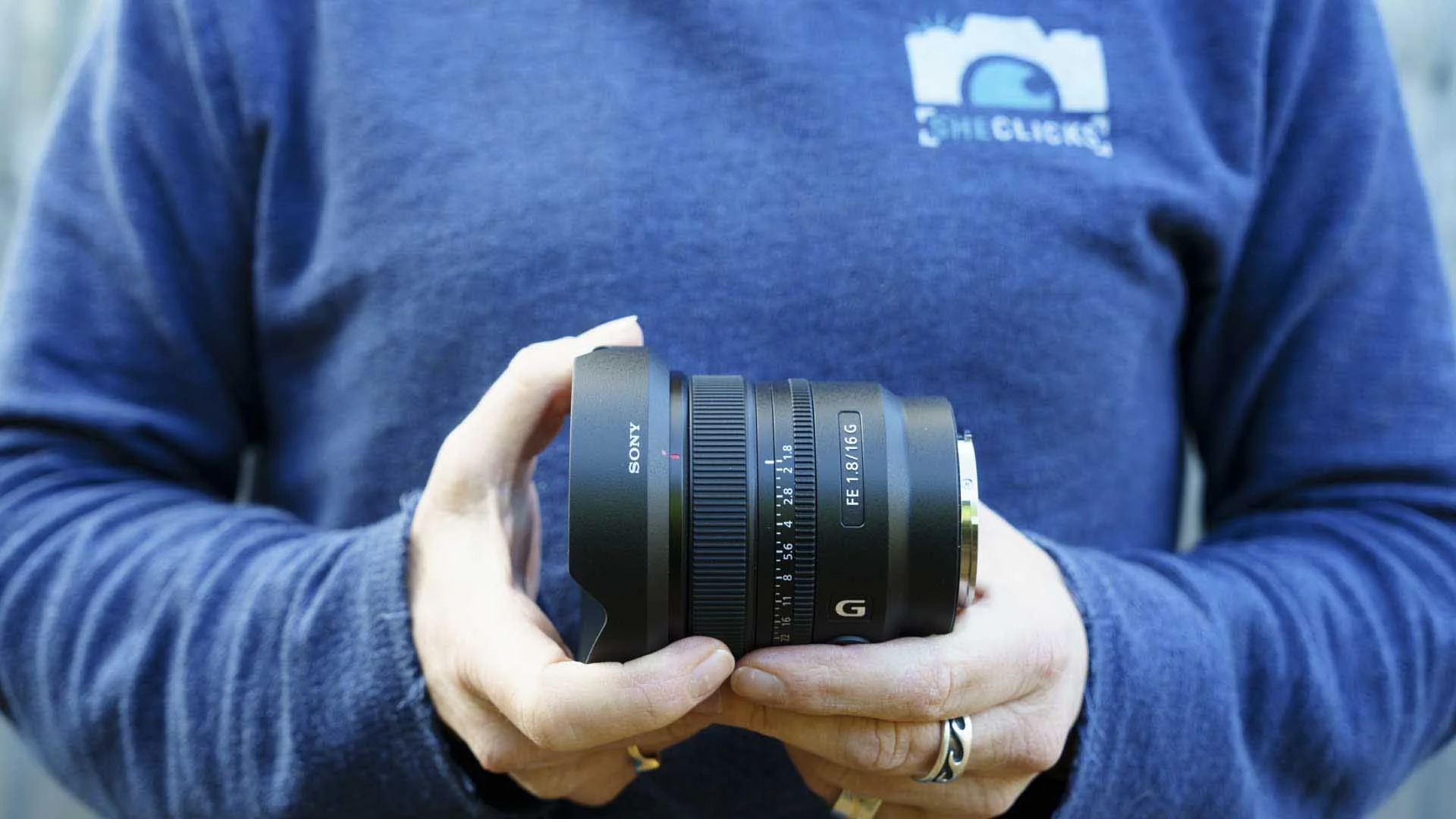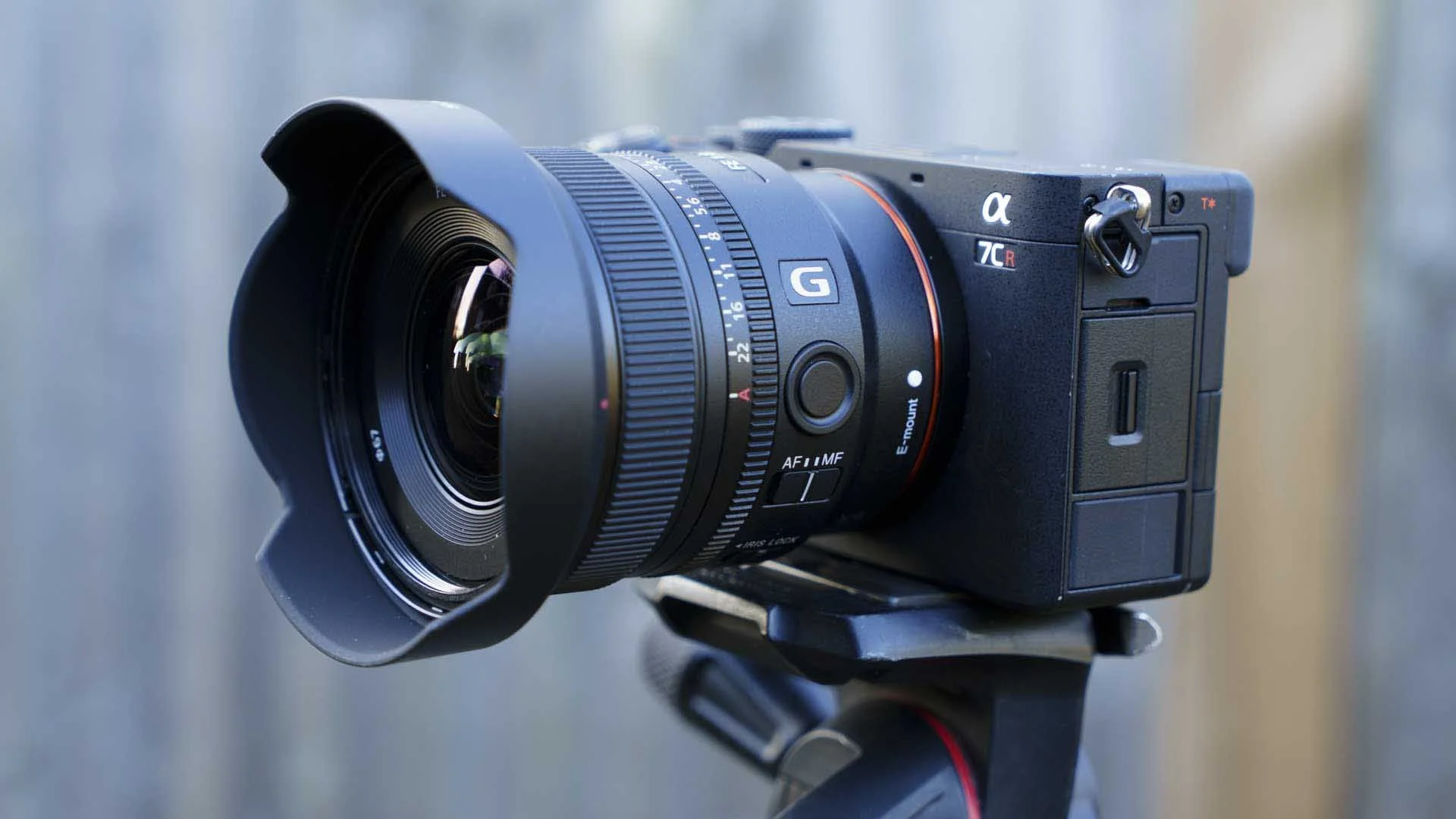Sony FE 16mm F1.8 G Review
Summary Verdict
The Sony FE 16mm F1.8 G is an exciting addition to Sony’s full-frame E-mount lineup. Its combination of wide-angle coverage, impressive resolution, fast aperture and compact design makes it an appealing choice for a broad range of photographers and videographers. Its fast and silent autofocus, minimal focus breathing and de-clickable aperture ring means it has plenty to offer anyone looking for a robust ultra-wide prime without stepping into G Master territory.
Score: 4/5
Pros
Lightweight and compact
Declickable aperture ring
Accepts screw-on filters
Cons
The corners look soft from around f/16 and smaller
Bokeh highlights rather harsh
What is the Sony FE 16mm F1.8 G?
The Sony FE 16mm F1.8 G is a compact, ultra-wide-angle prime (fixed focal length) lens for full-frame Sony E-mount cameras. Thanks to its fast maximum aperture of f/1.8 and compact size, it’s an attractive option for a range of photography and video applications, including arm’s-length vlogging, landscapes, astrophotography and cityscapes.
Sitting between Sony’s existing FE 14mm f/1.8 GM (£1,399) and FE 20mm f/1.8 G (£949) lenses, the 16mm f/1.8 G fills a gap in the lineup, offering a wider angle than the 20mm while avoiding the bulk and cost of the wider G Master. Unlike the FE 14mm f/1.8 GM, but like the 20mm lens, the FE 16mm F1.8 G can accept screw-on filters.
As a G series lens, the FE16mm f/1.8 G is more affordable than comparable GM serious optics.
Sony FE 16mm F1.8 G Price and Availability
The Sony FE 16mm F1.8 G‘s price is £850 (or €1000), and it went on sale in April 2025.
Specifications
Lens mount: Sony FE
Format: 35mm full frame
Focal length: 16mm (24mm equivalent on APS-C format)
Lens construction: 15 elements arranged in 12 groups with 3 ED, 1 Super ED and 3 Aspherical (including 2 AA lens) elements
Maximum aperture: F/1.8
Minimum aperture: F/22
Number of aperture blades: 11
Circular aperture: Yes
Minimum focus distance: AF: 0.15m, MF: 0.13m
Maximum magnification ratio: AF: 0.25x, MF: 0.3x
Filter diameter: 67mm
Hood type: Petal shape, bayonet type
Lens Coating: Multi-coating and Fluorine Coating on the front element
Focus mechanism: XD (extreme dynamic) Linear Motor with Internal focusing and linear response MF
Focus hold button: 1
Iris/Aperture ring: Yes, with click/de0-click switch and iris lock
Dust and moisture-resistant design: Yes
Dimensions (D x L): 73.8 x 75mm
Weight: 304 g
The Sony FE 16mm F1.8 G, shown here without its hood and rear cap, is compact and lightweight.
Key Features
Sony constructs the FE 16mm F1.8 G from 15 elements in 12 groups, incorporating three extra-low dispersion (ED) elements, one Super ED element and three aspherical elements (two of which are advanced aspherical, or AA). This design helps to suppress chromatic aberrations and maintain high resolution across the frame.
There’s an 11-blade aperture to enable smooth and rounded bokeh, which is most likely to be evident when shooting at the lens's closest focusing point of 15cm when using autofocus and 13cm when focusing manually.
Sony has given the lens two XD (Extreme Dynamic) Linear Motors for fast, precise and quiet autofocus. This contributes to the lens’ attraction for video shooting, where smooth and quiet focusing is essential. The lens also supports Sony’s Focus Breathing Compensation on compatible cameras, minimising shifts in the field of view when adjusting focus.
Although not stabilised, the lens is compatible with Sony’s stabilisation modes, including Active and Dynamic Active IS, making handheld video work more stable. Its lightweight build also makes it a great choice for gimbal use.
The Sony FE 16mm F1.8 G comes with a petal-type lens hood.
Build and Handling
Measuring just 75mm in length and with a diameter of 73.8mm, the Sony FE 16mm F1.8 G is attractively compact for an ultra-wide lens, especially given its large aperture. It also weighs only 304g, making it highly portable and well-balanced on both full-frame and APS-C format bodies. I’ve used it on the Sony A7R V, A1 II and ACR, and it makes a great match for all three cameras.
The Sony FE 16mm F1.8 G on the full-frame Sony A7CR.
The 67mm filter thread is another advantage over some other ultra-wide lenses that have a bulbous front element that necessitates a rear filter slot. It means you can attach an ND or polarising filter without a specialised holder. Urth Magnetic ND Selects Plus+ filters are my go-to ND filters these days; they snap on quickly and hold well.
Read our Urth Magnetic ND Selects Filter Kit Plus+ Review
Sony has included several useful controls on the lens barrel. Most noticeably, there’s an aperture ring with a de-click switch for smooth adjustments during video recording, and an iris lock to prevent accidentally switching between manual and automatic aperture selection. Plus, there’s a customisable focus hold button.
The finger-width focus ring towards the front of the lens uses Sony’s linear response manual focus system. This means that the focus shifts according to the degree of the ring rotation rather than its speed. It’s a more intuitive way of focusing.
Further good news is that the Sony FE 16mm F1.8 G is weather-sealed and there’s a fluorine coating on the front element. The former means you can use the lens in less-than-perfect conditions, while the latter helps keep the front element clean of smudges and water droplets.
The Sony FE 16mm F1.8 G’s aperture ring can be set to click or operate silently.
Performance
The Sony FE 16mm F1.8 G delivers excellent sharpness across the frame throughout most of its aperture range, including wide open at f/1.8. That said, it gets a little sharper when closing down from full aperture, with the corners becoming very impressively sharp at f/2.8. There’s a hint of softening through diffraction at f/16, especially at the corners, but it wouldn’t stop me from using that setting in most situations.
When the image is set to 100% magnification on a computer screen, the softening becomes more apparent in images shot at f/22, but again, I would use that setting if the circumstances called for it. However, it’s worth remembering that a 16mm lens offers extensive depth of field at f/11, and there’s a filter thread should you need to extend the exposure time.
Uncorrected, the raw files show pronounced barrel distortion, but the correction profile in Sony’s editing software and third-party software such as Adobe Camera Raw, straightens out the bowing lines. The corrections are ‘baked in’ the Jpegs, so they look undistorted straight from the camera.
Vignetting is extremely well controlled, with only the merest suggestion of corner shading visible in uncorrected raw files shot at f/1.8. It’s unlikely to be a problem.
Further good news is that the Sony FE 16mm F1.8 G’s focusing is quick, reliable and silent (at least to my ears). It copes well with subjects around its closest focusing distance (15cm) and delivers plenty of detail. While there is generally extensive depth of field in images from such wide lenses, if you focus on a close subject and shoot with a wide aperture, you can separate the subject from its surroundings through background blur.
Focus breathing is also minimal, so the framing hardly changes when the focus distance changes.
The only issue I have with the FE 16mm F1.8 G is that out-of-focus highlights tend to look rather harsh. Instead of soft, blurred edges, their outer is quite distinct and the onion ring effect is sometimes visible.
Sony FE 16mm F1.8 G Sample Images
These images were shot using the Sony FE 16mm F1.8 G on the Sony A7R V. Browse and download full-resolution images from the Sony FE 16mm F1.8 G. Please respect our copyright.
Thanks to its ultra-wide perspective, the Sony FE 16mm F/1.8 G enables you to fit a lot into an image from close quarters.
Image Credit: Angela Nicholson. Camera: Sony A7CR, lens: Sony FE 16mm F/1.8 G at f/5.6, 1/500 sec.
Going in close to a subject with a 16mm lens results in exaggerated perspective.
Image Credit: Angela Nicholson. Camera: Sony A7R IV, lens: Sony FE 16mm F/1.8 G at f/11, 1/640 sec.
This is the previous image after a couple of minutes of editing in Adobe Camera Raw - it’s what I had in mind when shooting the original raw file.
Image Credit: Angela Nicholson. Camera: Sony A7R IV, lens: Sony FE 16mm F/1.8 G at f/11, 1/640 sec.
Even at f/16, the FE 16mm f/1.8 G softens the background when you go in very close to a subject.
Image Credit: Angela Nicholson. Camera: Sony A7R IV, lens: Sony FE 16mm F/1.8 G at f/16, 1/60 sec.
At more usual focus distances, the Sony FE 16mm F/1.8 G delivers extensive depth of field at f/16 - both the statue and the building in the background are sharp here.
Image Credit: Angela Nicholson. Camera: Sony A7R IV, lens: Sony FE 16mm F/1.8 G at f/16, 1/30 sec.
The ultra-wide-angle nature of the Sony FE 16mm F1.8 G can give image a more dynamic perspective.
The Sony FE 16mm F1.8 G is compatible with Sony’s subject detection system and proved effective when photographing this sleepy dog, it went straight to his nearest eye.
If you go in close and shoot wide-open, subjects can be isolated from their surroundings. The out of focus areas also look pleasantly blurred.
The closest focusing distance of 15cm from the sensor when using the autofocus system makes the Sony FE 16mm F1.8 G extra versatile.
Verdict
The Sony FE 16mm F1.8 G is an attractive ultra-wide-angle prime lens. It balances good sharpness across the frame at all but the smallest apertures, great handling, fast autofocus and strong video credentials in a compact and lightweight package.
At £850, it provides a cost-effective alternative to the pricier 14mm f/1.8 GM, with only a small trade-off in field of view. It also offers a wider perspective than the 20mm f/1.8 G, catering to those who need an even more expansive angle.
It’s an attractive ultra-wide lens for a wide range of photographic genres, but especially travel where space and weight are a premium.














